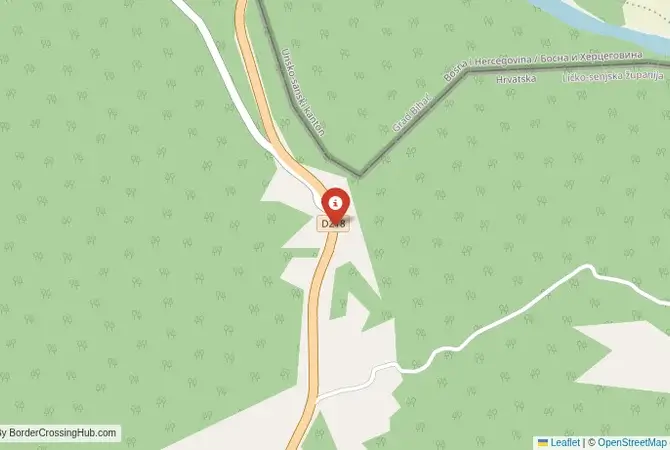
Approximate Border Location
Border Countries
Border Cities
- 🇧🇦Ripač
- 🇭🇷Užljebić
Wait Times
15-60 min for pedestrians/vehicles
Operating Hours
Open 6:00 AM – 10:00 PM
Crossing Types
Pedestrians, vehicles
Border Type
Land crossing via road
Peak Times
Mornings (7-10 AM)
Daily Crossings
~1500 travelers/vehicles
Currency Exchange
Limited near Ripač (BAM, EUR)
Safety Information
Rural, minimal crime
Languages Spoken
Bosnian/Croatian
Accessibility Features
Ramps, assistance
About Ripač & Užljebić
A Crossing in a Land of Emerald Rivers
The border crossing connecting the area near Ripač in Bosnia and Herzegovina with Užljebić in Croatia is a journey into one of the most beautiful natural landscapes in the Balkans. This is a secondary checkpoint, a quiet road that runs through the heart of the Una River valley. Since Croatia is a member of the European Union and the Schengen Area, this is an external border. To cross here is to travel through a landscape of pristine rivers, spectacular waterfalls, and dense forests, a passage that is defined by the stunning beauty of the Una National Park. It is a route for nature lovers, adventurers, and those seeking to escape the main tourist trails.
Operational Details
This checkpoint connects the Una-Sana Canton of Bosnia and Herzegovina with Lika-Senj County of Croatia. It is a smaller international crossing, and it is crucial to check its operational status and hours before travel, as it may not be open 24/7 and may have weight restrictions. It is intended for passenger cars and local traffic. The exclusion of heavy freight preserves the tranquility of this sensitive natural area. The road leading to the crossing is a scenic, winding route that follows the Una River, offering beautiful views but requiring a cautious driving pace.
Before Crossing
Crossing borders gets messy sometimes, think political flare-ups or gates shutting fast. Good travel insurance is a must for handling doctor visits, trip disruptions, or security scares. Don’t get caught unprepared. To find a policy that’s got your back, check out reliable plans today for peace of mind.
A History of a Partisan Republic
The history of this region is one of a rugged and resilient borderland. The nearby city of Bihać has been a strategic fortress for centuries. During World War II, the area was the heart of the Bihać Republic, a large territory liberated by the Yugoslav Partisans, where the foundational meetings of the future Yugoslav state (the AVNOJ sessions) were held. The modern border, established after the breakup of Yugoslavia, divided this historically integrated region. The opening of this border crossing has been crucial for the development of cross-border tourism, particularly focused on the magnificent Una National Park, which straddles the border.
The Schengen Border Procedure
The border crossing procedure is a rigorous process, reflecting its status as an entry point into the EU and the Schengen Area. You will first complete exit formalities at the Bosnian checkpoint at Ripač. After a short drive, you will arrive at the Croatian checkpoint at Užljebić for a full EU/Schengen entry inspection by the Croatian Border Police and Customs. You will need a valid passport. National ID cards are only sufficient for EU citizens. Vehicle registration and international insurance (Green Card) are also necessary. As a smaller crossing, the process is generally faster than at the main highways, but the checks are still thorough.
The Surrounding Region: Bosnia and Herzegovina Side
On the Bosnian side, the crossing is in the heart of the Una National Park. The park is famous for its spectacular travertine waterfalls, including the magnificent Štrbački Buk and the waterfalls at Martin Brod. The Una River, known as the “Emerald River,” is one of the purest and most beautiful in Europe, a world-class destination for rafting and kayaking. The nearby city of Bihać is a charming town situated on the banks of the Una, with a beautiful historic center and a vibrant cafe culture. The region is a paradise for outdoor adventure.
The Surrounding Region: Croatia Side
On the Croatian side, the crossing is in the remote and sparsely populated Lika region. The area is known for its rugged karst landscape and its pristine nature. The crossing is a gateway to the Plitvice Lakes National Park, a UNESCO World Heritage site and one of the most famous natural attractions in Europe, with its series of 16 interconnected, terraced lakes and spectacular waterfalls. The road from the border also connects to the main routes leading to the northern Adriatic coast.
Practical Travel Information
Practical planning is essential for this route. You must have a suitable vehicle and be comfortable with narrow, winding roads. Check the operating hours of the border before you travel. The official currencies are the Bosnian Convertible Mark (BAM) in Bosnia and Herzegovina and the Euro (EUR) in Croatia. There are no services at the border itself. You must be self-sufficient with fuel, food, and water. Ensure your vehicle’s Green Card insurance is valid for both countries.
Final Considerations
The Ripač–Užljebić border crossing is a route for the nature lover and the adventurer. It is a journey through a landscape of breathtaking natural beauty. It is not the fastest or the easiest way to travel, but it is by far the most scenic. It is a passage that connects two of the most magnificent national parks in the Balkans, the Una and the Plitvice Lakes. For those looking to explore the wild heart of the Dinaric Alps, it is an unforgettable experience, a border crossing that is a destination in itself.
See other crossings between Bosnia and Herzegovina and Croatia
See other crossings between Bosnia and Herzegovina and Croatia
No reviews yet.
